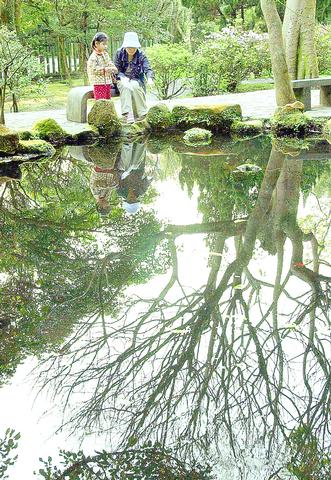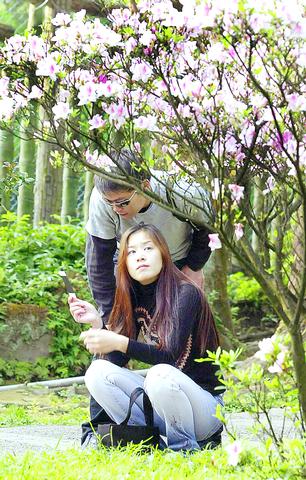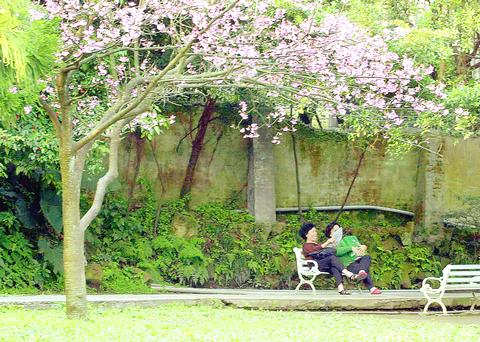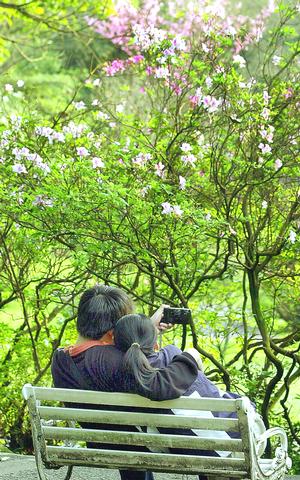Winter is almost behind us, and no event provides more evidence of the change of season than the Yangmingshan Flower Festival (
A wild variety of blooms have freshly emerged from their winter casing to make a riot of color, bringing welcome relief after another grey winter. So although there is plenty to see in Yangmingshan all year round, the flower festival, which lasts through March, is the main event of the season.

PHOTO: CHIANG YING-YING, TAIPEI TIMES
To deal with anticipated crowds, special traffic controls will be put into effect for the weekends, when huge numbers of visitors travel to the mountain to enjoy the blooms and fine weather.

PHOTO: CHIANG YING-YING, TAIPEI TIMES
This year, events for the festival have been coordinated by the Yangmingshan Studio (陽明山書院). There will be six guided tours of the Chunghsing Lodge (中興賓館), located on the 15-hectare studio grounds, during holiday weekends through March. The lodge, which first opened to the public in June, 1998, and has already attracted 200,000 visitors, was originally used to accommodate guests of state. The Yangmingshan
Two special tour programs have also been organized by the Yangmingshan park administration, one focusing on peonies and maples that ornament the Yangmingshan Studio grounds, and the second focusing on the abundant flora and fauna of nearby Tatun Mountain (大屯山).

PHOTO: CHIANG YING-YING, TAIPEI TIMES
The studio tours will take place on March 14 and March 21. The Tatun Mountain tours are scheduled for March 12 and March 19 and again on May 4 and May 11. Under the guidance of tour guides, visitors will have an opportunity to gain a deeper understanding of Yangmingshan and its surroundings. Openings are limited. For information on these tours contact (02) 2861-8744 ext. 3616.

PHOTO CHIANG YING-YING, TAIPEI TIMES
Traffic restrictions will be in force on holiday weekends during the flower festival period, so the Yangmingshan park administration recommends that visitors use public transport.
To reach Yangmingshan, the 260 bus from downtown Taipei is the best choice, which drops you off at the Yangmingshan Visitors Center (陽明山國家公園遊客中心). Or take the 9 minibus from Peitou (
For more information, visit: http://www.cpami.gov.tw/ymsnp/ymshome.htm

June 2 to June 8 Taiwan’s woodcutters believe that if they see even one speck of red in their cooked rice, no matter how small, an accident is going to happen. Peng Chin-tian (彭錦田) swears that this has proven to be true at every stop during his decades-long career in the logging industry. Along with mining, timber harvesting was once considered the most dangerous profession in Taiwan. Not only were mishaps common during all stages of processing, it was difficult to transport the injured to get medical treatment. Many died during the arduous journey. Peng recounts some of his accidents in

A short walk beneath the dense Amazon canopy, the forest abruptly opens up. Fallen logs are rotting, the trees grow sparser and the temperature rises in places sunlight hits the ground. This is what 24 years of severe drought looks like in the world’s largest rainforest. But this patch of degraded forest, about the size of a soccer field, is a scientific experiment. Launched in 2000 by Brazilian and British scientists, Esecaflor — short for “Forest Drought Study Project” in Portuguese — set out to simulate a future in which the changing climate could deplete the Amazon of rainfall. It is

What does the Taiwan People’s Party (TPP) in the Huang Kuo-chang (黃國昌) era stand for? What sets it apart from their allies, the Chinese Nationalist Party (KMT)? With some shifts in tone and emphasis, the KMT’s stances have not changed significantly since the late 2000s and the era of former president Ma Ying-jeou (馬英九). The Democratic Progressive Party’s (DPP) current platform formed in the mid-2010s under the guidance of Tsai Ing-wen (蔡英文), and current President William Lai (賴清德) campaigned on continuity. Though their ideological stances may be a bit stale, they have the advantage of being broadly understood by the voters.

Artifacts found at archeological sites in France and Spain along the Bay of Biscay shoreline show that humans have been crafting tools from whale bones since more than 20,000 years ago, illustrating anew the resourcefulness of prehistoric people. The tools, primarily hunting implements such as projectile points, were fashioned from the bones of at least five species of large whales, the researchers said. Bones from sperm whales were the most abundant, followed by fin whales, gray whales, right or bowhead whales — two species indistinguishable with the analytical method used in the study — and blue whales. With seafaring capabilities by humans